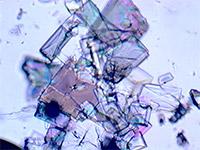SDSC Assists in Generating Clean Tech Breakthrough
SDSC’s Trestles Used to Develop New Tools for Cleaner Air and Energy Production
By:
- Cassie Ferguson
Published Date
By:
- Cassie Ferguson
Share This:
Article Content
Using the Trestles supercomputer at the San Diego Supercomputer Center (SDSC) at the University of California, San Diego, chemists at the University of South Florida (USF) and King Abdullah University of Science and Technology (KAUST) have discovered a more efficient, less expensive, and reusable material for carbon dioxide (CO2) capture and separation than is currently used to prevent the greenhouse gas from entering the atmosphere.

Photo credit: USF/Mike Zaworotko
The breakthrough could have implications for a new generation of clean-air technologies, and offers new tools for confronting the world’s challenges in controlling carbon.
In the findings, published in a recent issue of the journal Nature, the international group of scientists has identified a previously underused material, hexafluorosilicate – also known as SIFSIX-1-Cu – that offers a highly efficient mechanism for capturing CO2. Trestles, as part of the National Science Foundation’s (NSF) Extreme Science and Engineering Discovery Environment (XSEDE), helped to confirm experimental results suggesting the sorption properties (the physical and chemical process by which substances attach to each other) of the material.
The discovery represents more than an improvement over existing materials in terms of carbon capture, said USF Chemistry Professor Mike Zaworotko, noting that the material also is highly-effective at carbon capture even in the presence of water vapor, a standard that other materials have not been able to meet. This makes it a promising candidate for real-world applications. Water normally interferes with CO2 capture, but the material developed in the USF-KAUST project resists it.
“I hate to use the word ‘unprecedented’ but we have something unprecedented,” Zaworotko said. “We sort of hit a sweet spot in terms of properties.”
The discovery addresses one the biggest challenges of capturing CO2 before it enters the atmosphere: energy costs associated with the separation and purification of industrial commodities currently consumes around 15 percent of global energy production. The demand for such commodities is projected to triple by 2050, the researchers note.
The problem is pronounced in capturing CO2, which in addition to its notoriety with climate change, is an impurity in natural gas, biogas and other gas streams, they said.
The material is a crystal whose atoms form a three-dimensional lattice with holes that snare molecules of CO2 but allow other molecules in air to pass. SIFSIX-1-Cu is an adaptation of a material created more than 15 years ago and is named after the chemical component that leads to the special properties. Porous SIFSIX materials are built from combinations of inorganic and organic chemical building blocks and are part of a general class of materials known as Metal-Organic Materials, or “MOMs”.
The work has been several years in the making and began with an undergraduate research project conducted by USF student Stephen Burd under Zaworotko’s supervision. Now a graduate student in chemistry, Burd’s initial testing of the material and discovery of its high-selectivity for CO2 then grew to involve an international research group involving USF chemists Brian Space, Shengqian Ma, Mohamed Eddaoudi (who is also a faculty member at KAUST) and graduate collaborator Patrick Nugent.
The research facilities at KAUST in Saudi Arabia combined with the multidisciplinary expertise in Eddaoudi’s research group – which includes researchers Youssef Belmabkhout, Amy Cairns and Ryan Luebke – allowed the design of unique experiments that permitted the sorption properties of this class of materials to be unveiled.
To confirm their findings, the researchers ran simulations using the NSF’s XSEDE resources. Space's team initially used Molpro on the Pittsburgh Supercomputing Center’s Blacklight to simulate the behavior of small numbers of gas molecules with each other and with the MOM material. Predicting the exact behavior of even small numbers of molecules requires a huge amount of computer memory — more than one terabyte, greater than the RAM memory in a thousand brand-new iPads. Such calculations are a specialty of Blacklight, the largest “shared memory” computer in the world.
The researchers then used the Blacklight results to simulate the behavior of the gasses and the MOMs in bulk by running a Massively Parallel Monte Carlo (MPMC) code on XSEDE computers Trestles at SDSC and Ranger at the Texas Advanced Computing Center.
“We work with the experimental groups in a back-and-forth process,” Space said. “We tried to explain their data, and our results give them hints on how to change the way the material works.”
The group believes the material has three potentially significant applications: carbon-capture for coal-burning energy plants; purification of methane in natural gas wells; and the advancement of clean-coal technology. Some 20 to 30 percent of the power output at a clean-coal plant is consumed by cleaning process. The new material could make those plants more efficient and put more power into the grid, the scientists predict.
The next step is to collaborate with engineers to determine how the materials can be manufactured and implemented for real-world uses.
To read the full publication, “Porous Materials with Optimal Adsorption Thermodynamics and Kinetics for CO2 Separations,” visit the journal Nature here. A video animation by USF chemist Brian Space shows how the carbon atoms stick to the metal-organic framework material.
Share This:
You May Also Like
UC San Diego is Strengthening U.S. Semiconductor Innovation and Workforce Development
Technology & EngineeringStay in the Know
Keep up with all the latest from UC San Diego. Subscribe to the newsletter today.



